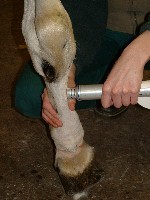Research Identifies Possible Shock Wave Treatment Markers in Horses
 Equine Science Update by: Mark Andrews
Equine Science Update by: Mark Andrews
Extracorporeal shockwave therapy (ESWT) is used to promote healing of injured tendons and ligaments. Using high-pressure sonic waves, ESWT is thought to increase blood flow to the treated area. It has been shown to reduce pain for several days after treatment.
This can cause problems if pain is masked before healing is complete. Overworked minor injuries could lead to major ones or even pose the risk of catastrophic life-threatening breakdown.
Competition authorities have introduced restrictions on horses participating after treatment. For example, the British Horseracing Authority banned the use of ESWT on the day of the race or on any of the preceding five days.
However, it’s one thing to restrict the use of ESWT; quite another to enforce a ban, as the therapy leaves no trace. That is, until now.
A team led by Mary Robinson, director of the University of Pennsylvania’s Equine Pharmacology Research Laboratory, and lab member Jinwen Chen has found that the practice does in fact leave a trail. In a paper in Equine Veterinary Journal, they report finding potential biomarkers of ESWT that, with further testing, could one day be used to enforce the ESWT ban.
“Because it’s not a drug–it’s applied to the surface of the skin–it’s just not an easy thing to detect,” says Robinson. “After a lot of trial and error, our study was able to measure changes in levels of five inflammatory factors, some of which we could detect up to three weeks after the shockwave therapy.”
The search for these biomarkers dates back roughly a decade.
“It was Dr. Lawrence Soma, my predecessor, who said the lab was going to have to look at blood-based or urine-based biomarkers to try to detect shockwave therapy,” Robinson notes.
To find the fingerprints that ESWT might leave behind, the researchers tested the therapy on 11 horses kept as a study herd at the University’s New Bolton Center. The researchers collected blood samples from the group of horses, composed of Thoroughbreds and Standardbreds, at several times both before and after each received a single dose of ESWT to a leg.
Over the years, the lab investigated various potential biomarkers – molecules that would indicate a horse received ESWT. They targeted 10 pro-inflammatory and anti-inflammatory signaling molecules, called cytokines, which they can measure from the blood using a sensitive test called ELISA, short for enzyme-linked immunosorbent assay.
“We looked a week before giving the shockwave therapy to see if there were any changes in the baseline period, due to changes in time of day or anything else, and didn’t see anything we could define as significant,” Robinson says. “And in the post-shockwave period we went out to three weeks.”
No changes were detected in five of the cytokines they examined. But the other five– TNF‐α, IL‐1β, IL‐1RA, IL‐6 and TLR2 – were significantly affected by EWST.
Of those, TNF‐α levels were significantly increased through the whole of the three-week post-therapy study period.
More study is necessary, Robinson emphasizes, before these biomarkers could be used to assess inappropriate use of ESWT in racehorses. For one, the researchers would like to see if measuring these same molecules in horses that are actively training and racing or that have an acute injury might change their results.
For that, she and her colleagues are actively pursuing follow-up studies to look at these biomarkers and other indicators using a biobank of samples from client-owned animals, including injured and active racehorses, treated at New Bolton Center.
The end goal is to keep the sport safe.
“Shockwave therapy is great as long as people rest the horse after using it,” she says. “We are concerned that it’s being abused in the racehorse industry and that it could potentially result in breakdowns. That’s exactly what we’re trying to avoid.”
For more details, see:
Inflammatory mediators are potential biomarkers for extracorporeal shockwave therapy in horses
J.‐W. Chen, D. Stefanovski, J. Haughan, Z. Jiang, R. Boston, L. R. Soma, M. A. Robinson
Equine Vet J (2019)
https://doi.org/10.1111/evj.13183










